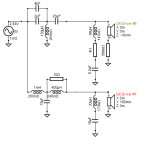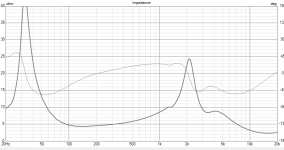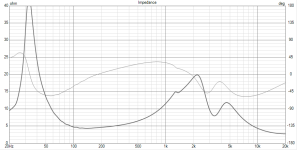I'll probably come back to you once I have hardware setup, but yeah making the .exe is what troubles me. It would be nice if ARTA could just call a .py script. The whole beauty of Python is not having to compile it, after-all. Else, a .exe that calls a .config text file to define com port, baud, special gcode etc would be next best thing. My main thinking is that others should be able to easily repeat what I do, not needing to understand python or compiling code (which I myself struggle with!).
Last edited:
It's pretty easymaking the .exe is what troubles me.
https://www.tomshardware.com/how-to/create-python-executable-applications
This way is good because it does not need python to be installed on the computer for the created exe to work. Some other methods still need python which makes it less universal for end users.
It's a wildly inefficient way to pass some angle commands but it works very well 🙂
Madisound just had a good deal on the Satori TW29BN, so I'll be seeing how the Be tweeter looks on my Textreme waveguide soon!
I will be posting some as I finish projects. But of course that assumes you intend to use the crossover and sensitivity in your design.
Sure, here's the crossover I've been working on for the SB15 and SB26, with a ~6" CTC distance. For use with the augpro elliptical waveguide.Anyone care to share a passive XO design using these WG?
Cheers
It's crossed at 2300hz, which isn't the ideal given the CTC, but I found it worked decently given the lower part count needed to suppress the woofer breakup while keeping the response flat, and without trading too much sensitivity. Given the evenness of the directivity, 5 bands of EQ can make the response very flat.
Measurements taken from my garage, but are fairly accurate above 1khz (I also measured my Polk R200 in the same way, and it matched very closely to Klippel measurements).
Attachments
Here is the 2600hz xover I was also working on as well. The woofer breakup can't be suppressed as much as the 2300hz xover, and the sensitivity is about 2db less. Theoretically it should have better directivity (I plan on measuring it tomorrow), so you can test it out and see which one you like more. Eventually I will get around to posting all of my updated work, I'll just post a link here to it so I don't gum up the thread.Anyone care to share a passive XO design using these WG?
Cheers
Attachments
And here are the results for the 2600hz xover:

compared to the 2300hz xover:

A bit less treble energy, and as suspected the directivity index is much smoother on the 2600hz xover. Hope this helps anyone looking for a passive xover for this particular use case!
compared to the 2300hz xover:
A bit less treble energy, and as suspected the directivity index is much smoother on the 2600hz xover. Hope this helps anyone looking for a passive xover for this particular use case!
Impedance above 10kHz is a little low.Here is the 2600hz xover I was also working on as well. The woofer breakup can't be suppressed as much as the 2300hz xover, and the sensitivity is about 2db less. Theoretically it should have better directivity (I plan on measuring it tomorrow), so you can test it out and see which one you like more. Eventually I will get around to posting all of my updated work, I'll just post a link here to it so I don't gum up the thread.
Why not just a parallel notch in series with the tweeter?
Would knock down the distortion much more as well 🙂
I
A bit smoother right at 2khz, but otherwise the 2300hz is smoother on-axis. I Iike the 2300hz result for that reason. The real subjective difference will be the 2dB difference all through the treble. Again I prefer the 2300hz here. Tilting down the response with these waveguides makes the sound too laid back, at least of you are used a conventional HiFi speaker.
A bit less treble energy, and as suspected the directivity index is much smoother on the 2600hz xover.
A bit smoother right at 2khz, but otherwise the 2300hz is smoother on-axis. I Iike the 2300hz result for that reason. The real subjective difference will be the 2dB difference all through the treble. Again I prefer the 2300hz here. Tilting down the response with these waveguides makes the sound too laid back, at least of you are used a conventional HiFi speaker.
I tried that in simulation, but I couldn't get an outcome that worked as well. I might try again in the future, but so far my measured distortion has been below .2% in the upper end.Impedance above 10kHz is a little low.
Why not just a parallel notch in series with the tweeter?
Would knock down the distortion much more as well 🙂
I agree on both accounts. The 2600 xover series notch resistor can be increased to ~7 ohms to bring the treble up a bit, but at the cost of the horizontal response.I
A bit smoother right at 2khz, but otherwise the 2300hz is smoother on-axis. I Iike the 2300hz result for that reason. The real subjective difference will be the 2dB difference all through the treble. Again I prefer the 2300hz here. Tilting down the response with these waveguides makes the sound too laid back, at least of you are used a conventional HiFi speaker.
Have you made plans for the rest of the box? Volume and tune? Baffle size?Sure, here's the crossover I've been working on for the SB15 and SB26, with a ~6" CTC distance. For use with the augpro elliptical waveguide.
This seems like a really economical little speaker!
@Mitch311 I have several 3d printed design for this arrangement; a small sealed box, small flat-tuned ported, a small hump-tuned ported, and a hump-tuned ported larger box. You can check them out at printables:
https://www.printables.com/model/661737-waveguided-bookshelf-speakers-using-sb15-woofer-an
I haven't updated the xover listen in the link, nor have I included build instructions and a few other odds an ins.
https://www.printables.com/model/661737-waveguided-bookshelf-speakers-using-sb15-woofer-an
I haven't updated the xover listen in the link, nor have I included build instructions and a few other odds an ins.
@chargedcapacitor
Ah thanks for sharing! That’s awesome.
I actually thought you meant this SB15: https://sbacoustics.com/wp-content/uploads/2020/11/5inx8in-SB15SFCR39-8.pdf
But the little guy is awesome too!
Ah thanks for sharing! That’s awesome.
I actually thought you meant this SB15: https://sbacoustics.com/wp-content/uploads/2020/11/5inx8in-SB15SFCR39-8.pdf
But the little guy is awesome too!
For some reason I like that woofer, very retro classic.Ah thanks for sharing! That’s awesome.
I actually thought you meant this SB15: https://sbacoustics.com/wp-content/uploads/2020/11/5inx8in-SB15SFCR39-8.pdf
But the little guy is awesome too!
I wish they made a bigger sized one as well (kinda in the style of B139).
I have already talked with SB about it, but they don't have any plans, unless you order a minimum of 250 or so.
That is a cool little guy as well, and it seems to share enough hardware to be in the SB15 class. I bet it would be great as a bass woofer in a slim 3-way!@chargedcapacitor
Ah thanks for sharing! That’s awesome.
I actually thought you meant this SB15: https://sbacoustics.com/wp-content/uploads/2020/11/5inx8in-SB15SFCR39-8.pdf
But the little guy is awesome too!
Took me a while to get used to the new CEA2034A capability in SoundEasy, but here are some results of the "ceramic" SB driver standmount so far. I'm optimizing for vertical reflections much more than in the past. And ceiling reflection takes priority over the floor reflection since most floors have rugs or carpet and coffee tables, while ceilings are always hard surfaces. In the crossover CAD, only Listening Window and Sound Power is currently included, although I've requested Bohdan add PIR and Early Reflections in future releases. It is really amazing how modeling diffraction with ABEC and using a waveguide makes the final design work so easy, and passive and active versions are almost identical. Normally you just have to live with the passive results, while you can EQ with active. The dip at 2.3khz is the woofer response, that might be one area I'll be able to improve with the active version. I also want to play with a lower crossover and LR2 in the active version.



Last edited:
Hahaha... my room has hard but beautiful wooden floors so not wanting to hide them I added sound damping on the ceiling.Took me a while to get used to the new CEA2034A capability in SoundEasy, but here are some results of the "ceramic" SB driver standmount so far. I'm optimizing for vertical reflections much more than in the past. And ceiling reflection takes priority over the floor reflection since most floors have rugs or carpet and coffee tables, while ceilings are always hard surfaces. In the crossover CAD, only Listening Window and Sound Power is currently included, although I've requested Bohdan add PIR and Early Reflections in future releases. It is really amazing how modeling diffraction with ABEC and using a waveguide makes the final design work so easy, and passive and active versions are almost identical. Normally you just have to live with the passive results, while you can EQ with active. The dip at 2.3khz is the woofer response, that might be one area I'll be able to improve with the active version. I also want to play with a lower crossover and LR2 in the active version.
View attachment 1247459View attachment 1247460View attachment 1247461
- Home
- Loudspeakers
- Multi-Way
- Open source Waveguides for CNC & 3D printing!




